2022
-
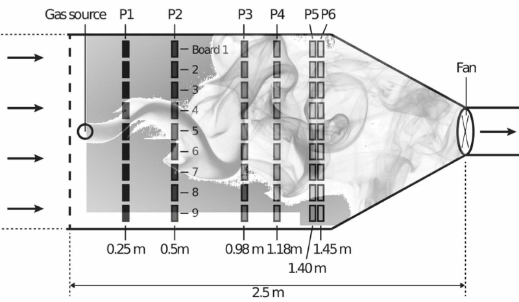
Drift in a popular metal oxide sensor dataset reveals limitations for gas classification benchmarks
Nik Dennler, Shavika Rastogi, Jordi Fonollosa, Andre Van Schaik, and
1 more author
Sensors and Actuators B: Chemical 2022
Metal oxide (MOx) electro-chemical gas sensors are a sensible choice for many applications, due to their tunable sensitivity, their space-efficiency and their low price. Publicly available sensor datasets streamline the development and evaluation of novel algorithm and circuit designs, making them particularly valuable for the Artificial Olfaction / Mobile Robot Olfaction community. In 2013, Vergara et al. published a dataset comprising 16 months of recordings from a large MOx gas sensor array in a wind tunnel, which has since become a standard benchmark in the field. Here we report a previously undetected property of the dataset that limits its suitability for gas classification studies. The analysis of individual measurement timestamps reveals that gases were recorded in temporally clustered batches. The consequential correlation between the sensor response before gas exposure and the time of recording is often sufficient to predict the gas used in a given trial. Even if compensated by zero-offset-subtraction, residual short-term drift contains enough information for gas classification. We have identified a minimally drift-affected subset of the data, which is suitable for gas classification benchmarking after zero-offset-subtraction, although gas classification performance was substantially lower than for the full dataset. We conclude that previous studies conducted with this dataset very likely overestimate the accuracy of gas classification results. For the 17 potentially affected publications, we urge the authors to re-evaluate the results in light of our findings. Our observations emphasize the need to thoroughly document gas sensing datasets, and proper validation before using them for the development of algorithms.
-
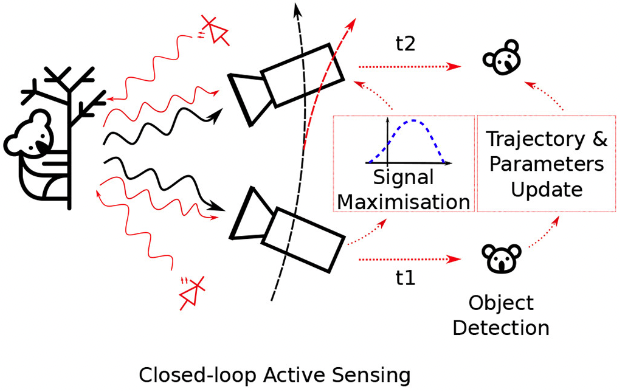
Neuromorphic Engineering Needs Closed-Loop Benchmarks
Moritz B Milde, Saeed Afshar, Ying Xu, Alexandre Marcireau, and
8 more authors
Frontiers in Neuroscience 2022
Neuromorphic engineering aims to build (autonomous) systems by mimicking biological systems. It is motivated by the observation that biological organisms - from algae to primates - excel in sensing their environment, reacting promptly to their perils and opportunities. Furthermore, they do so more resiliently than our most advanced machines, at a fraction of the power consumption. It follows that the performance of Neuromorphic systems should be evaluated in terms of real-time operation, power consumption, and resiliency to real-world perturbations and noise using task-relevant evaluation metrics. Yet, following in the footsteps of conventional machine learning, most Neuromorphic benchmarks rely on recorded datasets that foster sensing accuracy as the primary measure for performance. Sensing accuracy is but an arbitrary proxy for the actual system’s goal – taking a good decision in a timely manner. Moreover, static datasets hinder our ability to study and compare closed-loop sensing and control strategies that are central to survival for biological organisms. This paper makes the case for a renewed focus on closed-loop benchmarks involving real-world tasks. Such benchmarks will be crucial in developing and progressing Neuromorphic Intelligence. The shift towards dynamic real-world benchmarking tasks should usher in richer, more resilient, and robust artificially intelligent systems in the future.
-
Rapid Inference of Geographical Location with an Event-based Electronic Nose
Nik Dennler*, Damien Drix*, Shavika Rastogi, André Schaik, and
1 more author
In Neuro-Inspired Computational Elements Conference 2022
-

Rapid Recognition of Olfactory Scenes with a Portable MOx Sensor System using Hotplate Modulation
Damien Drix*,
Nik Dennler*, and Michael Schmuker
In 2022 IEEE International Symposium on Olfaction and Electronic Nose (ISOEN) 2022
A café, the metro, a supermarket, a book store —\,many locations of everyday life have a specific smell. Recognising such olfactory scenes could inform personal activity tracking, environmental monitoring, and assist robotic navigation. Yet it is unclear if current Metal-oxide (MOx) sensor technology is sensitive and specific enough to achieve this. Factors like sensor drift, and sensitivity to ambient humidity and temperature further complicate the recognition of olfactory scenes. Hotplate temperature modulation has been suggested as a method to counter these drawbacks. We present an electronic nose based on MEMS-MOx sensors that support rapid hotplate temperature modulation with a 150 ms period. We recorded different natural olfactory scenes in an urban context. A linear SVM was able to recognise four olfactory scenes in single hotplate cycles with near-perfect performance when trained and tested on the same day, and 73% accuracy when tested in the same locations on the next day. Gas sensor responses yielded higher recognition accuracy than humidity, temperature, and pressure, which were also partly-location specific. Our results indicate that hotplate modulation enables recognition of natural odor scenes across extended timespans. These findings encourage the use of MOx-sensors as rapid sensing devices in natural, uncontrolled environments.
2021
-
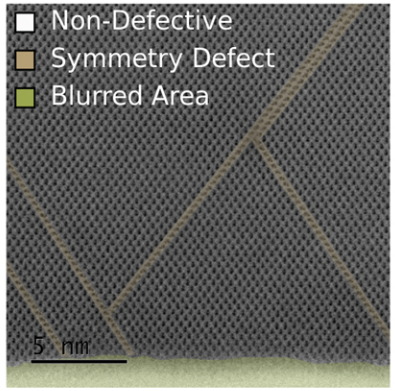
Learning-based defect recognition for quasi-periodic HRSTEM images
Nik Dennler, Antonio Foncubierta-Rodriguez, Titus Neupert, and Marilyne Sousa
Micron 2021
Controlling crystalline material defects is crucial, as they affect properties of the material that may be detrimental or beneficial for the final performance of a device. Defect analysis on the sub-nanometer scale is enabled by high-resolution scanning transmission electron microscopy (HRSTEM), where the identification of defects is currently carried out based on human expertise. However, the process is tedious, highly time consuming and, in some cases, yields ambiguous results. Here we propose a semi-supervised machine learning method that assists in the detection of lattice defects from atomic resolution HRSTEM images. It involves a convolutional neural network that classifies image patches as defective or non-defective, a graph-based heuristic that chooses one non-defective patch as a model, and finally an automatically generated convolutional filter bank, which highlights symmetry breaking such as stacking faults, twin defects and grain boundaries. Additionally, we suggest a variance filter to segment amorphous regions and beam defects. The algorithm is tested on III–V/Si crystalline materials and successfully evaluated against different metrics and a baseline approach, showing promising results even for extremely small training data sets and for noise compromised images. By combining the data-driven classification generality, robustness and speed of deep learning with the effectiveness of image filters in segmenting faulty symmetry arrangements, we provide a valuable open-source tool to the microscopist community that can streamline future HRSTEM analyses of crystalline materials.
-
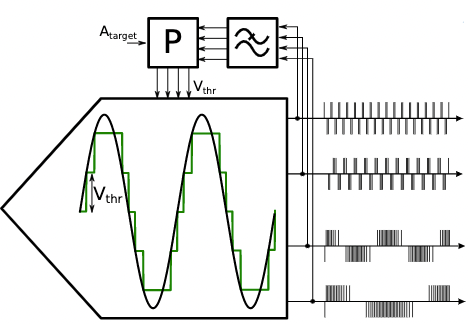
Online detection of vibration anomalies using balanced spiking neural networks
Nik Dennler, Germain Haessig, Matteo Cartiglia, and Giacomo Indiveri
In 2021 IEEE 3rd International Conference on Artificial Intelligence Circuits and Systems (AICAS) 2021
Vibration patterns yield valuable information about the health state of a running machine, which is commonly exploited in predictive maintenance tasks for large industrial systems. However, the overhead, in terms of size, complexity and power budget, required by classical methods to exploit this information is often prohibitive for smaller-scale applications such as autonomous cars, drones or robotics. Here we propose a neuromorphic approach to perform vibration analysis using spiking neural networks that can be applied to a wide range of scenarios. We present a spike-based end-To-end pipeline able to detect system anomalies from vibration data, using building blocks that are compatible with analog-digital neuromorphic circuits. This pipeline operates in an online unsupervised fashion, and relies on a cochlea model, on feedback adaptation and on a balanced spiking neural network. We show that the proposed method achieves state-of-The-Art performance or better against two publicly available data sets. Further, we demonstrate a working proof-of-concept implemented on an asynchronous neuromorphic processor device. This work represents a significant step towards the design and implementation of autonomous lowpower edge-computing devices for online vibration monitoring.
-

Decoupling of lattice and orbital degrees of freedom in an iron-pnictide superconductor
C. E. Matt, O. Ivashko, M. Horio, J. Choi, and
15 more authors
Phys. Rev. Research Jun 2021
The interplay between structural and electronic phases in iron-based superconductors is a central theme in the search for the superconducting pairing mechanism. While electronic nematicity is competing with superconductivity, the effect of purely structural orthorhombic order is unexplored. Here, using x-ray diffraction and angle-resolved photoemission spectroscopy, we reveal a structural orthorhombic phase in the electron-doped iron-pnictide superconductor Pr4Fe2As2Te0.88O4 (Tc=25 K), which is distinct from orthorhombicity in the nematic phase in underdoped pnictides. Despite the high electron doping we find an exceptionally high orthorhombic onset temperature (Tort∼250 K), no signatures of phase competition with superconductivity, and absence of electronic nematic order as the driving mechanism for orthorhombicity. Combined, our results establish a high-temperature phase in the phase diagram of iron-pnictide superconductors and impose strong constraints for the modeling of their superconducting pairing mechanism.
2018
-

Pressure-induced rotational symmetry breaking in URu 2 Si 2
Jaewon Choi, Oleh Ivashko,
Nik Dennler, Dai Aoki, and
7 more authors
Physical Review B Jun 2018
Phase transitions and symmetry are intimately linked. Melting of ice, for example, restores translation invariance. The mysterious hidden order (HO) phase of URu2Si2 has, despite relentless research efforts, kept its symmetry breaking element intangible. Here, we present a high-resolution x-ray diffraction study of the URu2Si2 crystal structure as a function of hydrostatic pressure. Below a critical pressure threshold pc≈3 kbar, no tetragonal lattice symmetry breaking is observed even below the HO transition THO=17.5 K. For p>pc, however, a pressure-induced rotational symmetry breaking is identified with an onset temperatures TOR∼100 K. The emergence of an orthorhombic phase is found and discussed in terms of an electronic nematic order that appears unrelated to the HO, but with possible relevance for the pressure-induced antiferromagnetic (AF) phase. Existing theories describe the HO and AF phases through an adiabatic continuity of a complex order parameter. Since none of these theories predicts a pressure-induced nematic order, our finding adds an additional symmetry breaking element to this long-standing problem.
* denotes equal contribution.
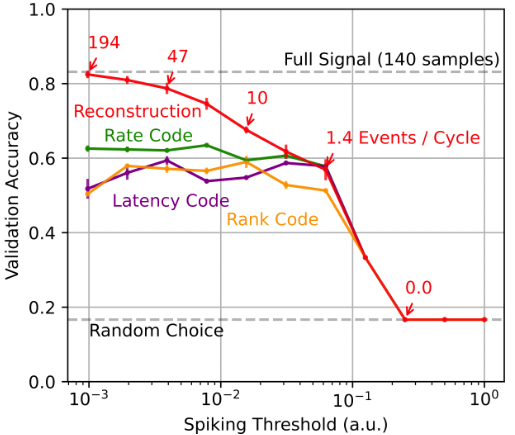 Rapid Inference of Geographical Location with an Event-based Electronic NoseIn Neuro-Inspired Computational Elements Conference 2022
Rapid Inference of Geographical Location with an Event-based Electronic NoseIn Neuro-Inspired Computational Elements Conference 2022